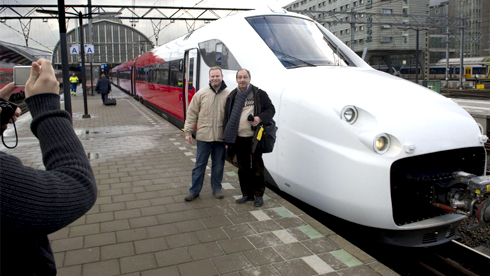With his admission that he is "sick and tired of it all,” the chief executive of the Belgian railway company NMBS, Marc Descheemaecker, has voiced the opinion of many travellers on the Fyra high-speed train.
The NMBS director let his anger show on January 21 during the TV programme De zevende dag, broadcast by VRT. Fyra, the train that should have been a high-speed rail link between Amsterdam and Brussels, is a fiasco. Punctuality was poor right from the start [see below], and since last weekend the train has not been running at all — a situation that may last several months.
Causes ranged from a swan on the tracks to infrastructural disruptions in Rotterdam. Also often cited were information and communication problems that delayed trains or even brought them to a complete standstill between stations for an indefinite period of time. It now appears that technical problems with the rolling stock, the V250, are also causing serious concerns.
Penny wise, pound foolish
Apparently the trains cannot cope with ice blocks. A piece of bodywork and a protection grill from the Fyra train were found on the tracks. No wonder therefore that the safety department of the Belgian railways imposed a traffic ban [on January 18].
Accusatory fingers are now being pointed at the manufacturer, the Italian company AnsaldoBreda, which issued a hasty apology. But the question is also why NS-Hispeed and NMBS opted for this supplier and not one of the better-known makers of rolling stock on the European network, such as Siemens, Alstom or Bombardier. A classic case of “penny wise, pound foolish”?
The Dutch infrastructure minister Wilma Mansveld (Labour Party) has committed herself to providing an alternative train service, according to a letter sent to the Lower House of the Dutch Parliament on January 22.
Patience worn thin
It also appears that the patience that she initially showed for problems with the Fyra has worn thin. She will use her powers to hold the transport operators to the agreements made when granting the concession, or force them to make new agreements.
That is the least she can do – along with obtaining an in-depth investigation, already demanded of NS and NMBS, into the cause of the debacle.
This also means reopening the Belgian-Dutch consultation on the high-speed rail link – not characterised by flexibility at the best of times – with the future of Fyra at stake.
Train passengers may only hope that the outcome is a timetable that they can depend on. After all, reliability takes precedence over the false promise of high speed.
Analysis
A failure in the making
As early as December, Le Monde wrote of “the curse of the Benelux train”, which struck the Fyra service a few days after its launch. The successor to a slow moving train, which for 55 years had taken three hours to make the 210km journey from Brussels to Amsterdam, Fyra “was to be operated by NS-Hispeed — an alliance between Dutch rail operator NS and KLM — and the National Railway Company of Belgium SNCB,” points out the daily, which enumerates the problems that affected the service from its very first day: delays, cancellations, damage to rolling stock etc. All of these were enough to give the impression that the project was “an industrial catastrophe”, and one that —
irked Belgian and Dutch travellers as much as the suspension of the Benelux train — a mini-revolution on which they were not consulted, which brought about an explosion in fare prices.
For its part, La Libre Belgique examines “the reasons for the fiasco”, which amounted to “a monumental, international flop” —
The Fyra project dates back to 1996, a time when Dutch and Belgian rail operators were hoping to compete with the Thalys service on the Brussels-Amsterdam line. The idea was to create a kind of low-cost TGV that would be less comfortable (notably with no onboard bar), but would offer considerably lower fares. The trend has since taken hold in Europe: now SNCF also wants to provide "low cost high-speed services". […] Fyra aimed to be accessible, and doubtless the low price proposed for rolling stock was one of the key factors for the initiators of the project. In 2003, the Italian manufacturer AnsaldoBreda was selected from a panel of seven potential builders to develop the Fyras. […] The company had relatively little experience of high speed train development, especially outside Italy.
However, the explanation for the fiasco was not solely technical, adds the newspaper —
According to some sources, the Belgian operator, which was urged on by its Dutch counterpart and politicians on both sides of the Moerdijk [a region and a nickname for the Belgian-Dutch border], dragged its feet when embarking on the Fyra project. ‘There was a lot of political pressure, explains Ronny Balcaen of the Belgian green party Ecolo. We had built a high speed line, and we had to have trains to run on it’.
Was this article useful? If so we are delighted!
It is freely available because we believe that the right to free and independent information is essential for democracy. But this right is not guaranteed forever, and independence comes at a cost. We need your support in order to continue publishing independent, multilingual news for all Europeans.
Discover our subscription offers and their exclusive benefits and become a member of our community now!












